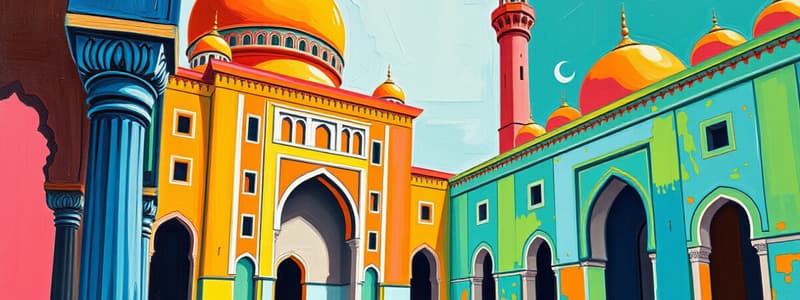Podcast
Questions and Answers
What characterizes the tombs of the Sayyed period?
What characterizes the tombs of the Sayyed period?
- They are based on an octagonal ground plan. (correct)
- They are circular in shape.
- They are square-shaped.
- They are constructed primarily of marble.
Which Lodi Sultan is credited with founding Agra City?
Which Lodi Sultan is credited with founding Agra City?
- Muhammad Lodi
- Sikandar Lodi (correct)
- Ibrahim Lodi
- Bahlul Lodi
How are the tombs of the Lodi period categorized?
How are the tombs of the Lodi period categorized?
- By their architectural style.
- By their shape: square and octagonal. (correct)
- By the materials used in construction.
- By their historical significance.
What distinguishes the Lodi period in Indo-Islamic culture?
What distinguishes the Lodi period in Indo-Islamic culture?
Which two cities were founded during the Sayyed period?
Which two cities were founded during the Sayyed period?
Study Notes
Sayyed-Lodi Phase (1414-1526)
- Represents the fourth phase of Indo-Islamic culture development during the Sayyed and Lodi Sultans.
Sayyed Sultans (1414-1450)
- Khizr Khan established Khizrabad and Mubarak Shah founded Mubarkabad, both important cities.
- Significant tombs from this period include the Tomb of Mubarak Shah and the Tomb of Muhammad Shah Sayyed.
- The tomb structures were characterized by an octagonal ground plan, showcasing architectural advancements.
Lodi Sultans (1451-1526)
- Marked by extensive construction of cities, tombs, and mosques with a notable emphasis on maqbaras (tombs).
- Associated with the phrase "period of tombs" due to the prolific number of grave sites built, as noted by Percy Brown.
City Development
- Sikandar Lodi, the second Lodi Sultan, founded Agra City in 1504, shifting the capital from Delhi to Agra, which significantly influenced regional politics and trade.
Tomb Architecture
- Lodi-era tombs classified into two primary styles:
- Square-shaped/Quadrilateral Tombs (Chaukor/Chaturbhuji Maqbaras), known for their four-cornered design.
- Octagonal Tombs (Athpathu/Ashtbhuji Maqbaras), featuring eight sides, indicating varied architectural preferences and techniques during this time.
Studying That Suits You
Use AI to generate personalized quizzes and flashcards to suit your learning preferences.
Description
Explore the Sayyed and Lodi phases of Indo-Islamic culture through significant architectural developments, including key tombs and the establishment of important cities. Discover how these periods shaped the region's political and cultural landscape, particularly the transition of the capital to Agra. This quiz provides insight into the rich history and artistry of the time.




